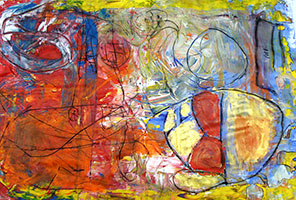January 2014
An art program for children inspired by Abstract Expressionist artists and their techniques — Jackson Pollock, Willem de Kooning, Brice Marden and especially the squeegee paintings of Gerhard Richter.
Begun in 2012, Astor’s “Paint What You Feel” art series uses abstract expressionist art to help emotionally charged children release their emotions in a productive, confidence-building way.
The Squeegee Shall Set You Free
Patrick Madden, artist and creator of the program, explains:
“We try to take these kids’ worst disadvantage and turn it into their biggest advantage — they have an unlimited supply of emotional torque, or from an artist’s perspective, fuel. My job is to help them get those feelings onto the canvas. Abstract expressionism has shown us the way, especially Gerhard Richter’s squeegee paintings. The heck with what it looks like. I care more about what the painting feels like.
‘Don’t paint a bird,’ I tell the kids, ‘Paint what it feels like to fly!'”
Building Self-Worth
What we strive to do is help kids pull together their life narrative which may be saturated with trauma storylines. The children often don’t have the verbal language to assemble that story. The Paint What You Feel art program helps them do that. You see in these paintings a landscape of their unconsciousness — what it feels like to be them. It’s a great place for us to begin to re-tell and rebuild their story.
So, when a child says, “I am going to fill in all the empty places with blue clouds.” he might be talking about more than just paint.
Equally as important, art becomes a way to build a child’s self-worth. The child sees another person — a peer, a teacher, a stranger — admiring not only the art but admiring the person that created that piece of art. It’s an intimate experience that builds the child from within. That is a beautiful moment to witness.
— Dr. Jody Popple,
Astor Residential Treatment Team Leader.
A Case History: Zack B
— Astor Residential Staff
Zack B came to Astor/Rhinebeck in 2008, from another residential care facility with a history of trauma and a very unsettled family situation.
Zack arrived just as Astor was adding an after school art program that moved away from a representational approach (and all the frustrations that come with that) to a more abstract expressionist approach, with a focus on expressing the child’s emotions.
Zack was an intensely sensitive and emotional child with limited verbal skills and no reliable vehicle for expressing his feelings.
Abstract painting gave him that release.
The weekly painting sessions were integrated into Astor’s overall program for Zack: medical, educational, therapeutic, family programs, and residential/life skills.
Slowly but surely, Zack began to change. The art program was a catalyst. Staff and fellow students began to see him not as an outcast, but as an artist — and a really, really good one. The emotions that were once locked inside his head became beautiful explosions of color and were hanging on the wall for all to see, Zack included.
“Zack, what are you gonna’ be when you grow up?!”
— Mother of Astor child/artist
“An artist!!”
Zack’s work dominated the 2011 and 2012 Astor Art Shows.
A Brooklyn-based art dealer commented: “An incredible artist — the juxtaposition of colors, the energy used in the application of the paint. WHAT!!?? He’s 13!!??”
Astor’s Dr. Jody Popple: “Art became a means for Zack to share the unspeakable — a voice to reconstruct an alternative, empowering story where he was his own hero.”
It gave a young man a much needed burst of confidence, a way to express his emotions. It changed the way he looked at himself. And, it changed the way his peers saw him — from “he’s odd” to, as one fellow student said, “Zack is weird cool.”
In other words, an artist.
Zack moved on to a program much closer to his home in northern New York. He goes on regular and extended home visits. His relationship with his mother and his siblings continues to grow.
And, now every new art session at Astor begins with the students looking at images of Zack’s paintings. He set an example for others to follow.
Astor Art Program Vision
“Our goal is to create a self-sustaining program that works hand in hand with all of the programs at Astor — to take it from an ad hoc program to one that is a key ingredient in Astor’s offering. Based on the effectiveness of the program to date, we would like to gradually expand it to include all or most of Astor’s 33 facilities and the 6,000 children and families we reach every week.”
— Sonia Barnes-Moorhead, Executive Vice President, The Children’s Foundation of Astor
View more of the art, and learn how you can purchase paintings or prints to support Astor, HERE
To learn more about Patrick Madden, artist and “Paint What You Feel” program creator, visit him online


